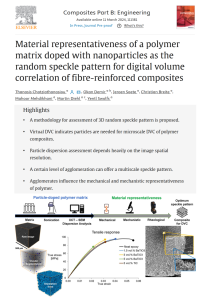 Abstract
Abstract
Combining tomographic imaging with digital volume correlation allows in-situ 3D strain mapping, leading to a quantitative assessment of damage mechanisms and associated material properties in structural materials. Being based on pattern recognition, digital volume correlation is well-suited for materials with intrinsic and stable microstructural heterogeneity, such as certain biological tissues. Unfortunately, conventional polymers and fibre-reinforced polymer composites lack the required heterogeneity. Recently, solutions like doping the polymers with particles have been explored to overcome this limitation. The particles embedded in the polymer matrix provide a random, volumetric speckle pattern, acting as displacement trackers for the digital volume correlation algorithm. However, the particles might influence the mechanical and rheological behaviour of the polymer, which is detrimental in investigations of the composite material properties. This paper investigates the mechanical, mechanistic, and rheological representativeness of an epoxy doped with two types of sub-micrometre particles optimised for digital volume correlation. Since particle dispersion is considered a key driver for representativeness, we simultaneously quantitatively assess the dispersion by combining scanning electron microscopy and X-ray computed tomography.
